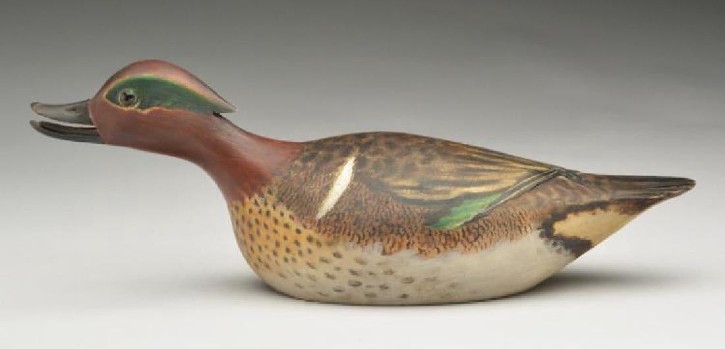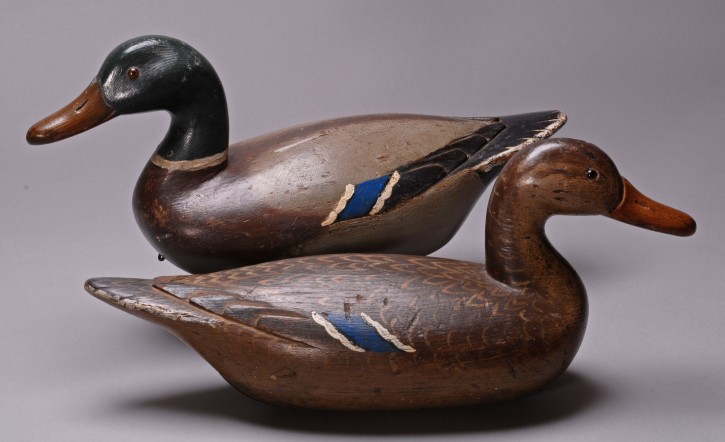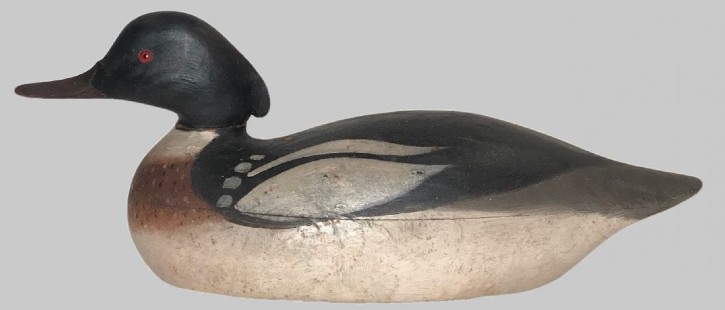
NEW YORK – Originally made to be functional, used in rigs by hunters to coax birds flying overhead into a “safe” landing, carved wooden bird decoys are now recognized as wonderful examples of folk art. Early decoys retaining original paint by well-known carvers are highly sought after.
Collectors are passionate and there are dedicated decoy auctions and shows as well as museums avidly collecting decoys and other wildlife art. The late Cape Cod auctioneer, Richard Bourne, held the first decoy auction in 1967, selling decoys from renowned collector Bill Mackey. Interest among sport hunters and folk art collectors was high enough to merit one sale a year there, and by 1983, Bourne was holding three sales a year.
Decoys can be full-bodied or hollow, and posed in standing, swimming, preening or sleep. They were decorated with glass or painted eyes and ornately painted wings and feathers. While most decoys made were ducks, carved swans and other birds are not uncommon but were generally made as folk art, not hunting.
Decoy carving was a popular pastime for many, especially where lakes are plentiful. A handful of carvers have gone on to become renowned in this field with some of their most desirable decoys bringing huge sums. Names like Anthony Elmer (A.E.) Crowell, Charles Perdew, Ken Harris, the Ward Brothers, Robert Elliston, Shang Wheeler, Joseph Lincoln are among the field’s blue-chip carvers. Two of Crowell’s decoys, a Canada goose and a preening pintail drake, each fetched over a million dollars in 2007 in a private sale brokered by sporting art specialist Stephen O’Brien Jr. Fine Arts.

Ted Harmon, who owns Decoys Unlimited, Inc., with his wife Judy, said Crowell (1862-1952) was one of the finest commercial decoy makers in New England and an extraordinary carver. “What I like most is his interpretation and lifelike positions of his more expensive decoys,” he said. “By the time he was in his 30s and 40s, he was creating some of the finest waterfowl decoys embellished with stunning and colorful soft feather paint patterns that required several layers of dry-brushed paint with the final product having a soft feather-like appearance.”
Crowell was about 30 to 50 years ahead of his time and supplied hunters with his basic simple designs for as little as 25 cents each around the turn of the century, Harmon said. If buyers wanted Crowell’s top-grade embellished decoys with deep relief wings and tail carving, however, the price rose to $24 a dozen. “Crowell’s iconic decoys are his racy swimming mergansers,” Harmon said.
Another renowned decoy maker was Joseph Whiting Lincoln (1859-1938) from Accord, Mass., near Boston, who is said to have begun carving miniature decoys as a child and made stunning wood duck drakes. Harmon praises Lincoln’s highly stylized paint patterns and his unique and stately form. “In fact, if you look closely, you can still see whittle marks,” he said. “His decoys were said to be finished with a knife only. Almost all his decoys were made with the heads erect and facing forward.”
Charles Perdew was born in 1874 in Illinois and began to carve at age 14. He is noted for decoys that were finely carved around the eyes and nostrils. “The bottoms were the classic Illinois River design with a ‘V’ shape to withstand the river’s current,” according to Guyette and Deeter, auctioneers specializing in decoys. “Thriving on the influx of seasonal hunters traveling down for the hunting seasons along the Illinois River, as well as local hunters, Perdew made decoys and even fixed the weapons of the hunters that came around.” Charles and his wife, Edna, worked together. He did the sculpting and Edna did the finishing work and painting. The pair became renowned folk artists. The world auction record for a Charles Perdew decoy is for a mallard hen Guyette & Deeter Inc. sold for $252,000 in 2007.

Micah Brosnan, who created the West Coast Decoys website, said one of the best Pacific Flyway carvers was Richard Ludwig “Fresh-Air Dick” Janson (1872-1951). A fisherman, marine carpenter and decoy maker who was born in Estonia and lived in Sonoma Creek, Calif., Janson was actively making decoys, circa 1900 to 1945. He is said to have earned his nickname for his penchant as a sailor of sleeping on deck in all kinds of weather. “Janson used raw muscle power and primitive hand tools to fashion his decoys with redwood bodies and sugar pine heads,” Brosnan said. Most of his decoys are solid but hollow-body models using precision-fitted chest plugs have been seen. Janson is best known for his pintails followed by mallards, canvasbacks, bluebills and green-winged teal. “The high-necked pintails are rare and only a few high-necked canvasbacks are known to exist,” Branson said. “Janson’s final product was a simple, graceful and solid design with an intrinsic aesthetic.”

Charles Edward “Shang” Wheeler (1872-1942) of Stratford, Conn., made beautifully carved/painted and realistic decoys for his own use and gave many of his best decoys to good friends. “His decoys were made in the great tradition of the Stratford School of carving and modeled initially after Albert Laing. Wheeler’s black duck sleepers are considered his signature bird,” Harmon said.

While the Mason Decoy Co. was a factory, not a single artisan, its decoys were and are highly prized. It made decoys in several grades, led by Challenge grade (#2) and Premier grade (#1). “Their best painters did a superb job and the paint is very durable perhaps because William Mason was in the paint business first as he supplied Detroit automakers with high quality and durable paint for their cars,” Harmon said.
While the antiques market has seen ebbs and flows, decoys have been insulated somewhat, retaining strong demand over the decades. As a specialized niche and holding crossover appeal with both folk art and sporting collectors, decoys continue to entrance admirers today.


